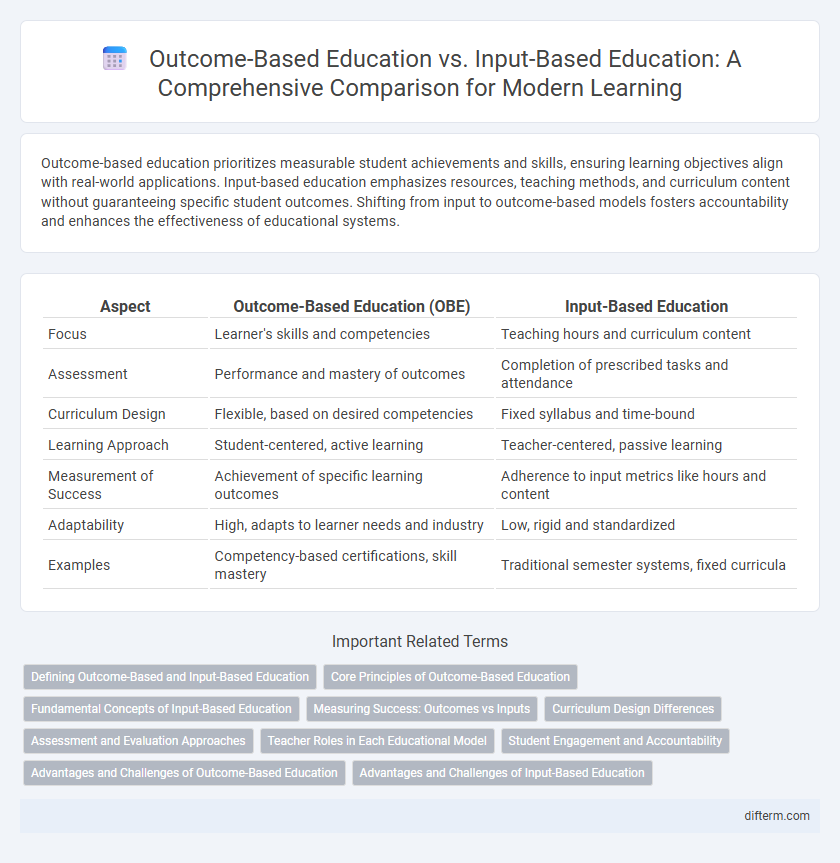Outcome-based education prioritizes measurable student achievements and skills, ensuring learning objectives align with real-world applications. Input-based education emphasizes resources, teaching methods, and curriculum content without guaranteeing specific student outcomes. Shifting from input to outcome-based models fosters accountability and enhances the effectiveness of educational systems.
Table of Comparison
| Aspect | Outcome-Based Education (OBE) | Input-Based Education |
|---|---|---|
| Focus | Learner's skills and competencies | Teaching hours and curriculum content |
| Assessment | Performance and mastery of outcomes | Completion of prescribed tasks and attendance |
| Curriculum Design | Flexible, based on desired competencies | Fixed syllabus and time-bound |
| Learning Approach | Student-centered, active learning | Teacher-centered, passive learning |
| Measurement of Success | Achievement of specific learning outcomes | Adherence to input metrics like hours and content |
| Adaptability | High, adapts to learner needs and industry | Low, rigid and standardized |
| Examples | Competency-based certifications, skill mastery | Traditional semester systems, fixed curricula |
Defining Outcome-Based and Input-Based Education
Outcome-Based Education (OBE) centers on clearly defined learning outcomes, specifying the knowledge, skills, and attitudes students must demonstrate by the end of a course or program. Input-Based Education emphasizes the resources, instructional time, curriculum content, and teaching methods delivered to students rather than the results of learning. While OBE measures success through student performance and competencies, Input-Based Education focuses on the quantity and quality of educational inputs without direct assessment of learning achievements.
Core Principles of Outcome-Based Education
Outcome-Based Education (OBE) centers on clearly defined learning outcomes that students must demonstrate upon course completion, emphasizing measurable skills and competencies over input variables such as time spent or resources used. Core principles of OBE include alignment of curriculum, instruction, and assessment with specific outcome goals, flexibility in teaching methods to accommodate diverse learner needs, and continuous improvement based on feedback and performance data. This approach contrasts with Input-Based Education, which focuses on instructional hours and content coverage rather than actual student achievement or mastery of skills.
Fundamental Concepts of Input-Based Education
Input-based education emphasizes the resources and processes involved in teaching, such as curriculum content, instructional materials, teacher qualifications, and classroom hours. Its fundamental concept prioritizes standardized inputs, assuming that consistent educational delivery leads to uniform student performance. This approach often measures success by compliance with prescribed educational inputs rather than actual learning outcomes or competencies gained by students.
Measuring Success: Outcomes vs Inputs
Outcome-based education (OBE) measures success by evaluating the specific skills, knowledge, and competencies students achieve, ensuring alignment with predefined learning outcomes. In contrast, input-based education focuses on resources such as curriculum content, teaching hours, and faculty qualifications without directly assessing student performance. Emphasizing measurable results in OBE fosters accountability and continuous improvement, whereas input-based education may overlook actual student learning and mastery.
Curriculum Design Differences
Outcome-based education (OBE) emphasizes designing curriculum around specific, measurable learning outcomes that students must achieve, ensuring alignment with real-world skills and competencies. Input-based education prioritizes curriculum content delivery, focusing on the resources, teaching hours, and subject coverage without guaranteeing that students attain mastery of the material. The fundamental difference lies in OBE's student-centered approach promoting measurable achievements, whereas input-based models depend primarily on standardized content delivery and instructional processes.
Assessment and Evaluation Approaches
Outcome-based education (OBE) centers assessment and evaluation on measurable student achievements and competencies, ensuring alignment with specific learning outcomes and real-world skills application. Input-based education relies heavily on evaluating resources, instructional time, and curriculum content delivery, focusing more on the educational process rather than student mastery. In OBE, continuous formative assessments and performance-based evaluations drive improvement, while input-based approaches often depend on summative tests and standard compliance metrics to gauge success.
Teacher Roles in Each Educational Model
In outcome-based education, teachers act as facilitators who guide students toward achieving specific learning outcomes, emphasizing mastery and competency development through continuous assessment. In contrast, input-based education positions teachers primarily as content deliverers who focus on syllabus coverage, instructional time, and standardized testing to determine student progress. The shift from input to outcome models transforms teacher roles from mere knowledge transmitters to mentors fostering critical thinking and personalized learning pathways.
Student Engagement and Accountability
Outcome-based education prioritizes measurable student engagement and holds students accountable for mastering specific competencies, fostering active participation and deeper understanding. Input-based education emphasizes curriculum delivery and instructional time, often neglecting individual student engagement and limiting accountability to attendance or completion metrics. Shifting to outcome-based frameworks enhances accountability through performance assessments and encourages students to take ownership of their learning progress.
Advantages and Challenges of Outcome-Based Education
Outcome-Based Education (OBE) emphasizes mastering specific competencies, which leads to clearer learning objectives and measurable student performance. The advantages include personalized learning paths, enhanced critical thinking skills, and greater accountability in teaching effectiveness. Challenges involve curriculum redesign complexity, the necessity for comprehensive assessment systems, and potential resistance from educators accustomed to traditional input-based models.
Advantages and Challenges of Input-Based Education
Input-based education prioritizes standardized curricula, teaching hours, and resource allocation to ensure uniformity across educational institutions. Its advantages include ease of administration, clear guidelines for teachers, and straightforward assessment of compliance with educational standards. Challenges involve limited flexibility for addressing diverse student needs and insufficient focus on measuring actual learning outcomes or skill acquisition.
Outcome-based education vs Input-based education Infographic

 difterm.com
difterm.com